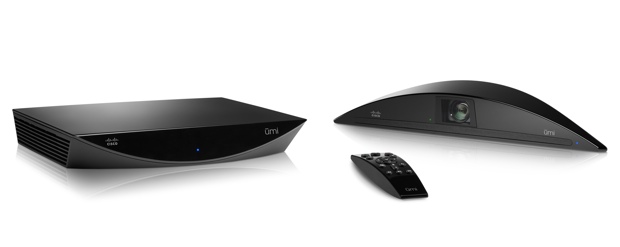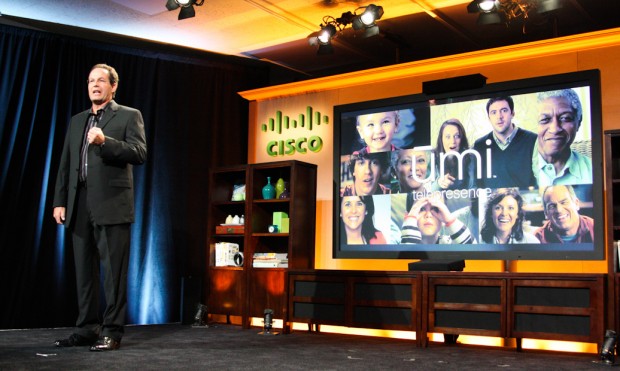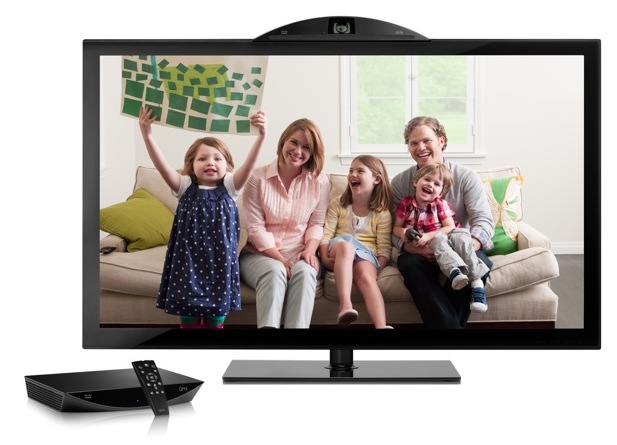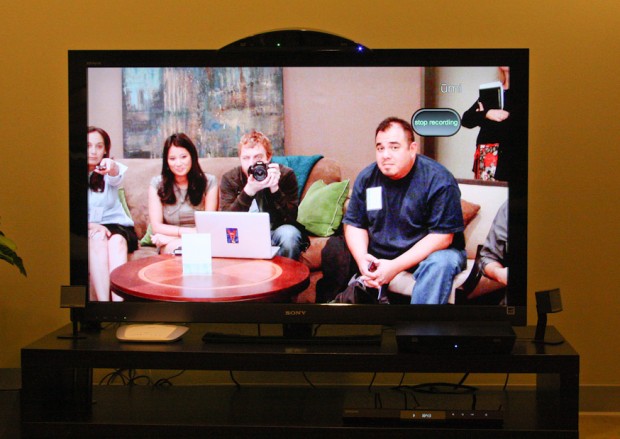
The rumors were true: Cisco has announced a new video calling system called ūmi (pronounced yoo-mee), which allows for easy 1080p video calling between your TV and any other ūmi system or Google Video Chat. Sounds great, although the $599 price, plus $24.99 per month for access to the service, may severely limit the uptake of this otherwise impressive piece of kit.

The ūmi system is made up of a camera unit, a console box, and a remote. It should work with any HD television and broadband internet connection (the TV itself need not be online), and will adjust the quality of the video automatically to accommodate fluctuations in bandwidth.
The camera can zoom and pan mechanically, and it has a motorized shutter so you can actually cover it up. A good solution to the “all-seeing eye” in your living room. The console has HDMI out for connecting to your TV, and HDMI in just in case you need to pass your set-top box signal through it; it will also connect wirelessly if that’s more your speed. The remote looks like a remote, and is used to control the usual camera functions, and for navigating the menus, making and answering calls, and so on.

Cisco emphasized the clarity and definition of the image, and the experience of having someone “life-size” on your TV. I couldn’t wheedle any specs for the camera out of them, but at the wide end it looked like about 40mm, and it had about an 8x zoom. This is purely speculation on my part. F-numbers were not provided, but it didn’t seem to have any trouble in a normally lit room.
They’ve also integrated some basic phone functions, like video voice mail, call blocking, and so on. You can check your messages on your laptop (at the ūmi site), but not on your phone, though it will notify you there. You can also record videos (up to 720p/30) and share them via email, YouTube, Facebook, and likely a few other services as time goes on. They’re partnering with Verizon to bring ūmi to FiOS customers in 2011, though costs weren’t mentioned.
The pricing, however reasonable or competitive Cisco thinks it may be, is in my eyes prohibitively expensive when a 1080p webcam and a large, high-definition monitor can be had for the same price, and free video call services are thick on the ground on your PC. Of course, no one likes the webcam experience, and ūmi does look much more accessible (sitting on your couch talking, zooming in and out, etc), but will people be willing to pay?
The ūmi will be available for pre-order on October 6th (tomorrow), and will be shipping on November 11th.
Update: After a brief hands-on, it appears that video quality is quite good; details of pillows and such showed up well, color and contrast appeared to be good. I did notice banding and occasional artifacting, which was explained as adjustment of bandwidth. Zooming in didn’t significantly lower the brightness, and we were able to read a crossword puzzle held by someone sitting perhaps eight or nine feet from the camera.
Cisco made made mention of this being a “first release,” in which (in response to our question) a few features may be missing, like the ability to set the volume for your call notifications. The on-screen display (the “clover”) is a bit large, but disappears on command or after a period of inactivity. The video answering machine looked good, and leaving a message seemed easy enough (you can save, rewind, fastforward, and so on). Google Chat integration is nonexistent; calls can be made, but you can’t have Google contacts in your clover.
And yes, it is only one to one video calling. There is no conference call ability at this time, which is extremely disappointing. For such a substantial sum and a monthly fee, you’d think they’d want to have feature parity with far less expensive platforms.
I could definitely see my parents using this, but I definitely also see them balking at the price tag. You can get a 1080p Microsoft Lifecam Studio webcam for $100, and the video quality seems comparable. There didn’t seem to be any actual plans for integration with existing internet-enabled TVs and apps.
Bandwidth requirements are quite high: 3Mbit/s upload rate for 1080p, 1.5Mbit/s for 720p. They say it will dynamically adjust the quality within those rates, but as another reporter mentioned while I was talking to Cisco reps, they’re pricing themselves out of a lot of homes there.
